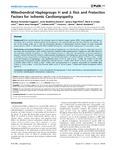Mitochondrial haplogroups H and J: risk and protective factors for ischemic cardiomyopathy

Ver/
Use este enlace para citar
http://hdl.handle.net/2183/19367Coleccións
- INIBC-MMIC - Artigos [1]
- INIBIC- REUMA - Artigos [184]
Metadatos
Mostrar o rexistro completo do ítemTítulo
Mitochondrial haplogroups H and J: risk and protective factors for ischemic cardiomyopathyAutor(es)
Data
2012-08-28Cita bibliográfica
Fernández-Caggiano M, Barallobre-Barreiro J, Rego-Pérez I, et al. Mitochondrial haplogroups H and J: risk and protective factors for ischemic cardiomyopathy. Plos One [Internet]. 2012 Ago 28 [acceso 2017 Ago 29];7(8):e44128. Disponible en: http://journals.plos.org/plosone/article/file?id=10.1371/journal.pone.0044128&type=printable
Resumo
[Abstract] Background. Since mitochondria are the principal source of reactive oxygen species (ROS), these organelles may play an important role in ischemic cardiomyopathy (IC) development. The mitochondrial genome may influence this disease. The aim of the present study was to test the relationship between IC development and the impact of single nucleotide polymorphisms (SNPs) in mitochondrial DNA (mtDNA) defining the mitochondrial haplogroups in a population study.
Methodology and principal findings. Ten major European haplogroups were identified by using the single base extension technique and by polymerase chain reaction-restriction fragment length polymorphism. Frequencies and Odds Ratios for the association between IC patients (n = 358) and healthy controls (n = 423) were calculated. No convincing associations between classical risk factors for ischemic cardiomyopathy development and haplogroups were found. However, compared to healthy controls, the prevalence of haplogroup H was significantly higher in IC patients (40.0% vs 50.0%, p-value = 0.039) while the frequency of haplogroup J was significantly lower (11.1% vs 5.6%, p-value = 0.048). The analysis of the SNPs characterizing the European mtDNA haplogroups showed that the m.7028C allele (40.0% vs 50.0%, p-value = 0.005) and m.14766C allele (43.0% vs 54.2%, p-value = 0.002) were overrepresented in IC patients, meanwhile the m.10398G allele (19.8% vs 13.1%, p-value = 0.015) and m.4216C allele (22.2% vs 16.5%, p-value = 0.044) were found as protective factors against IC.
Conclusions and significance. Our results showed that the haplogroups H and J were found as a risk and protective factors for ischemic cardiomyopathy development, respectively.
Versión do editor
Dereitos
Atribución 3.0 España
ISSN
1932-6203






